A variety of animals are bred in aquariums. But even with all their diversity, goldfish are well-deserved popularity - they are known even to people far from aquariums. It is useful to understand what this view is and how to handle it.
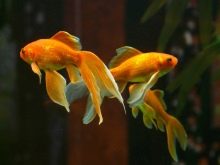
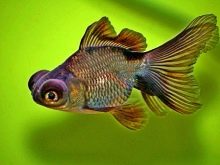

Classification by size and body shape
They brought goldfish in imperial China about 1,500 years ago. The starting point in the selection work was silver carp. Bred fish settled both in ponds and in luxurious vases.
Later, breeders did not stop their work, and as a result, many attractive varieties were created. It is customary to distinguish two categories of breeds.
Some of them - with a large long body - look like their ancestral form (wild crucian carp). Feature of large goldfish are:
- significant mobility;
- noticeable stamina;
- long life (sometimes reaching 20 years);
- reduced oxygen demand.
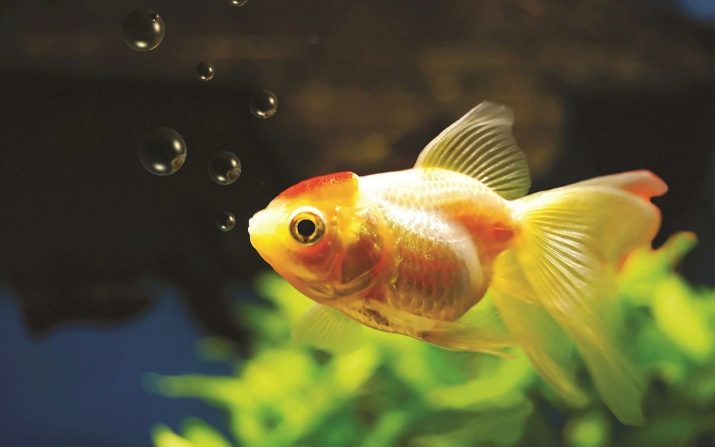
This group includes:
- ordinary goldfish (the one that is most often called that);
- comet;
- vaccine.
Short-bodied individuals deserve attention. They are characterized by a variety of appearance.
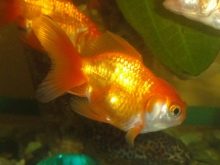

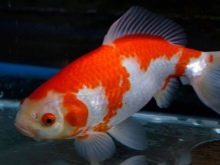
Moreover, any fish of this group in the head is wider than in the tail. It is important to understand that such a physique is not the norm for aquatic organisms.
Due to the ichthyological experiment, a number of negative consequences were obtained, such as:
- weakened immunity;
- loss of body tone;
- frequent illnesses;
- difficulty adapting;
- shorter life span;
- increased demands on conditions of detention.
Experienced people are aware of such a paradox - small aquarium goldfish need even a larger aquarium than their large relatives.
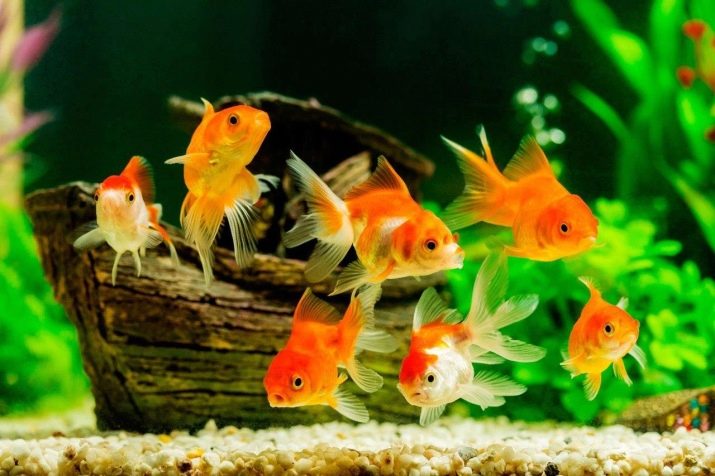
An equally important point is the need for an increased concentration of oxygen. Therefore, care is significantly difficult.
It should be borne in mind that in different countries there are their own species names of goldfish. This is explained by the fact that they were withdrawn simultaneously in various states.
Species of individuals in the shape and length of the fins
It is appropriate to start the description with the most common (what are called) goldfish. It was this breed group that was created first of all on the basis of wild crucian carp. They are similar to their ancestors in the geometry of the main surface of the body and in the configuration of the fins. The difference is expressed in tonality (golden-red color is characteristic).

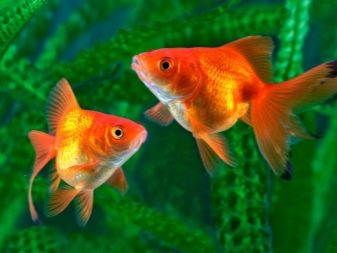
Important: simple gold must be kept in ponds, which contain many plants, but at the same time, there is plenty of room for swimming.
Species aquariums are preferred. If this cannot be ensured, a completely peaceful neighborhood must be guaranteed. Ordinary gold ones need a varied, well-balanced diet. Use the nutritional compositions of the plant and animal world. Forms can be various - and granular preparations, and tablets, and sticks, and frozen food.
Wakins are better known as the Japanese type of goldfish. They differ from their Chinese counterparts in a rugged physique. The tail can be single or double, but in both cases it is slightly elongated. The vaccine reaches a length of 0.3 m. The color of this breed variety can be white and red, and mixed colors are also found.
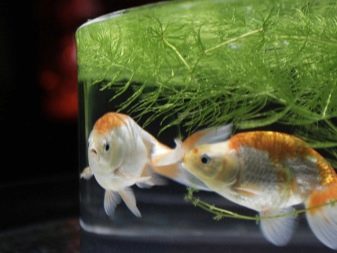

Comets acquired the main name for excessive mobility - often these fish pop out of open aquariums. They practically do not give offspring.
But comets contain easy and simple. The length of adults is limited to 0.15 m, the elongated tail bifurcates. For information: the longer the tail, the more valuable a particular individual is considered, while the other fins are only slightly elongated.

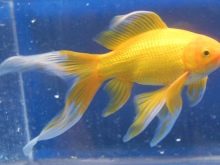
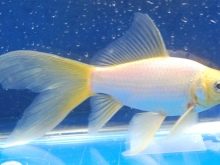
A swollen comet is a breed marriage. But the most popular fish with unequal coloring of the body and fins.
As for artificially bred varieties, the fantail is quite popular. This type was first introduced in China, but not in antiquity, but in the middle of the XIX century. Such a fish is characterized by:
- bloating;
- dominant orange-red tone;
- length 0.1 m;
- tail of two fully or partially fused halves with a transparent strip around the perimeter.

In fan tails, a dorsal fin of considerable height is formed. The remaining protrusions on the case have a normal or slightly increased length. The life span of a fantail is approximately 10 years.
Even more popular among artificially cultivated varieties is veiltail. It’s easy to recognize him - these goldfish are perceived as a ball or egg, crowned with a large head. Vail tails can grow to 0.2 m. The longest life span is 15 years. Scales are not always present. Elongated fins have a small thickness. The tail is formed by several fused lobes, and together they look like a veil or a magnificent dress.
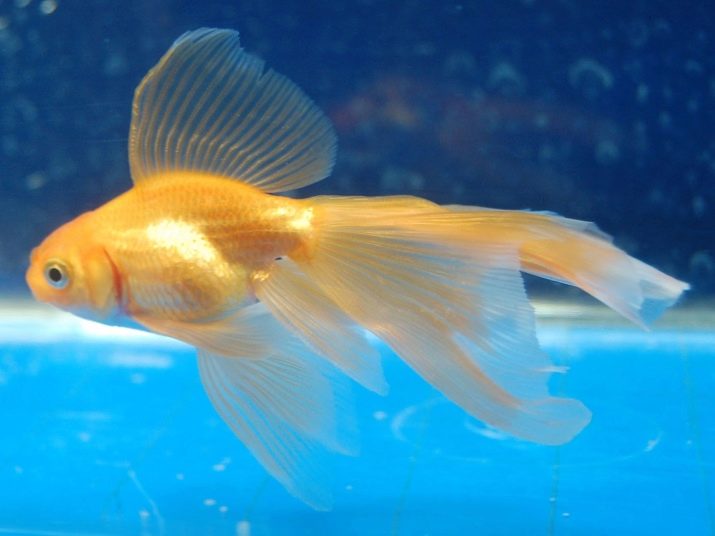
You can find veils of golden, white or motley color. The latter type is quoted above all by aquarists.
Such a Japanese type as riukin is noteworthy. He is characterized by:
- relatively large sizes;
- enlarged front part;
- mottled oskras of the head;
- relatively high dorsal fin;
- division of the tail into 3 or 4 segments;
- monotonous or motley coloring.
Curious that It was on the basis of the Rukins that the veiltail was brought out.
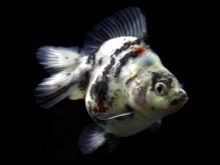
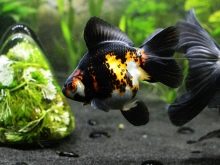
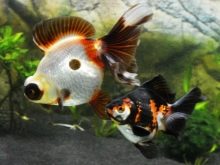
Fancy Scales
In the goldfish family the pearl stands out not only in a rounded shape. All scales are raised up, like a dome.A dark strip is located around their perimeter. This peculiar “chain mail” resembles a dense layer of pearls. If part of the scale is deformed, it will soon grow back, but without an elegant strip.
The pearl case reaches a length of 0.07-0.08 m. On its back, the fin is placed vertically, and all other fins are assembled in pairs. Their length is not too long. The tail is clearly divided into 2 blades that do not hang down. Pearls can have a gold, white and red-orange color.
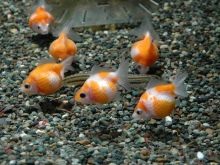
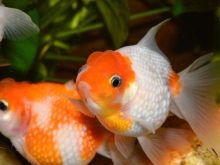
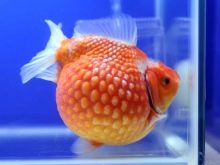
But the external beauty of pearls should not overwhelm people. It must be clearly understood that caring for this fish is more difficult than usual.
Due to the unusual geometry of the body, many aquarists overfeed or insufficiently feed it. But the pearl fry look very funny. By 8 weeks, they already resemble adults, second only to them in size.
Lionheads also have very unusual scales. True, in structure it does not differ from the usual, but it can have 2 or 3 colors in each flake. There are other fish options:
- with transparent scales;
- with pearlescent color;
- without scales at all.
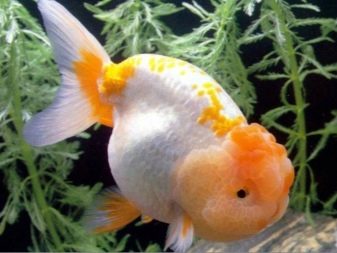
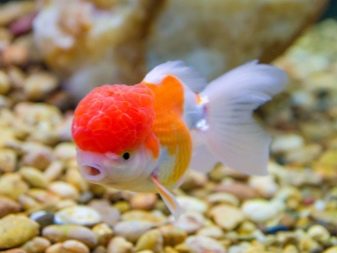
Groups of fish with growths on the head
This category includes a goldfish - water eyes, which has another name - bubble eyes. It is such a view that many consider the strangest among other representatives of this decorative group. It is already noteworthy that on the trunk 0.15-0.2 m long there is no dorsal fin. There are bubbles located on the underside of the eyes. Although such areas sometimes reach 25% of the entire length of the body, they are very gentle and sensitive to all external influences.
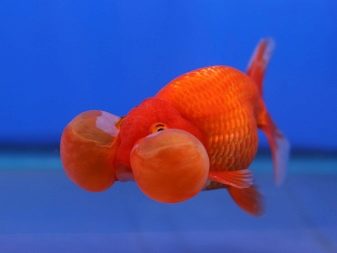
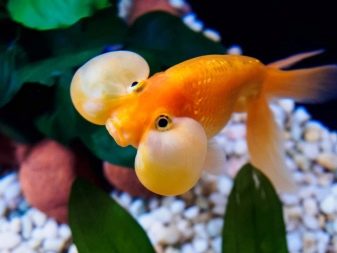
If the aquarist tastes exactly bubble eyes, then you need to free the aquarium from all sharp, stitching, and even other types of fish. Catch and transplant their wards will have to be as careful as possible.
Oranda has growths that are slightly different in appearance - they are located both on the head, and to a lesser extent on the gills. Abroad, this fish is sometimes called the goose head. There are white, mottled, black orandas, but red ones are valued as highly as possible.
Lion head got its name also because of the characteristic, resembling a mane of growths. Sometimes, however, they cause associations not with the back of the head of an African predator, but with a raspberry. Growths at the time of growing up cover the entire volume of the head. The dorsal fin of the lionheads is absent; the other fins are small in length. The tail of such fish is divided into 2 or 3 parts.
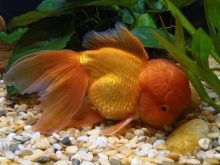
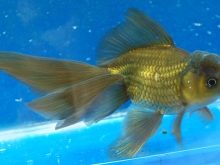
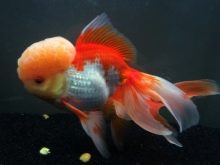
In Chinese and Japanese aquariums, they are considered a breeding ideal.
Ranch - These are the lion heads from Korea. There are almost no external differences from the previous view. However, growths are formed not by 3 months of life, but after 2-3 years. Note: some ranches do not have growths, but are covered with medium-sized colored dots on the lips, eyes, fins. The surface of the fish is colorless.
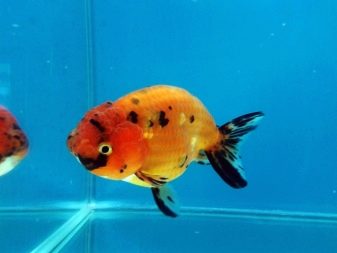
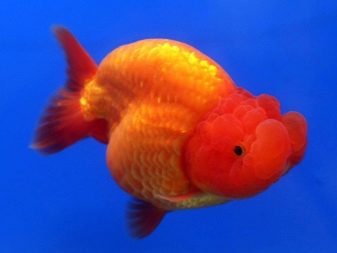
Color Overview
There are goldfish of various tones. So, just the red key has its own analogues - pale pink and fiery red. You can still see a goldfish of white, black and blue, pure black, dark bronze and yellow. Shubunkin looks very beautiful, he is also a comet - “chintz” coloration of this fish is formed by blue, red, black and white blotches. It is curious that the Shubunkins do not have scales.
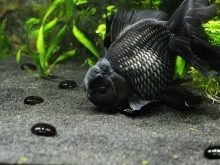
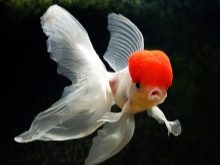
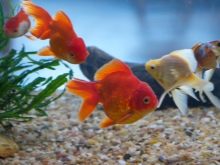
For the stargazer, he is also the eye of heaven, characterized by an orange-golden tone, like an orange peel. Body length can be 0.15 m.
Immediately attracts attention also Bristol Shubunkin. Already by name it is easy to guess where it comes from. Normal for "Bristol" coloring is a blue background, on which violet, orange, brown, yellow, red and black spots are placed.
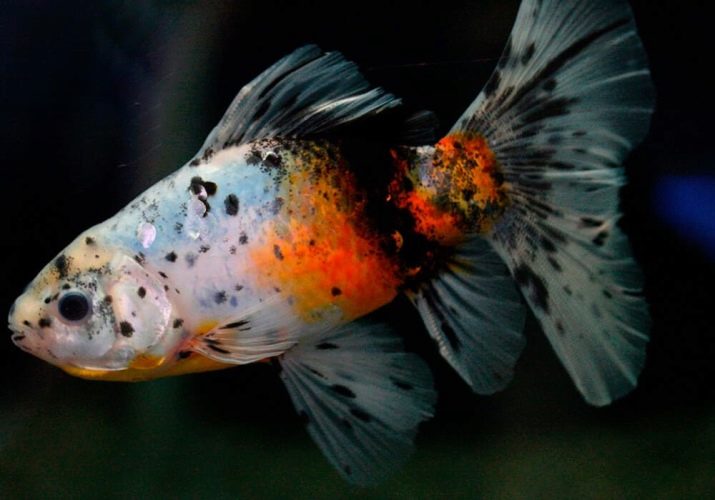
Jikin, he's a peacock or peacock tail, has 6 red parts of the body, and everything else is painted white. Note: getting a clean line of this breed is very difficult.Therefore, even in Japan, many prefer to remove extraneous pigments from white surfaces of the body.
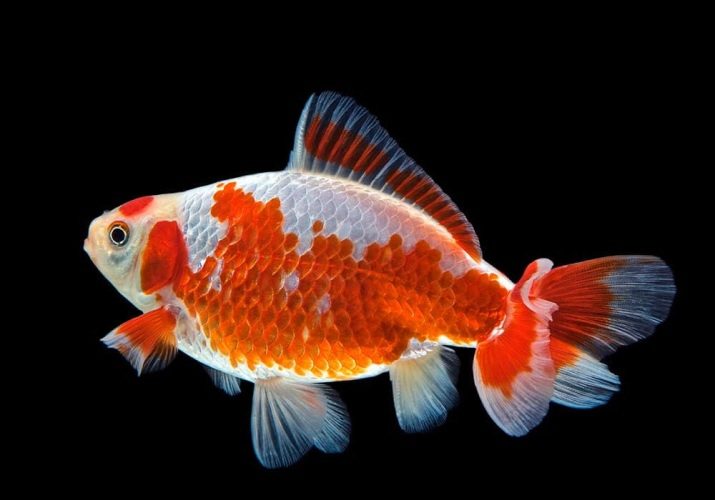
Now it is useful to consider the same topic in a general way. One cannot say anything special about one-color varieties - one tone is one tone.
Spotted (or otherwise motley) is called a fish, which have different parts of the body in color. Tricolor individuals are isolated into a separate group. And the type of coloring “motley scales” means that in a single flake you can see 2 or more colors. And also highlight the colors "panda" and "Little Red Riding Hood." These names eloquently describe the appearance of fish.
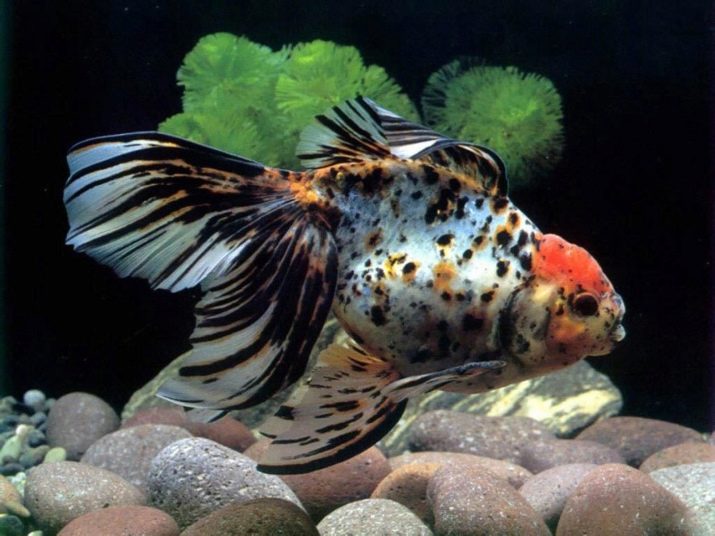
How to choose?
Deciding on the species of goldfish for an aquarium is easier than it seems by their variety. If you focus on those species that have the most diverse colors, then for a start it is worth taking a closer look at fan tails and veil tails. If you want to stand out as much as possible, fit tosakin — this species is very rare and is intended for keeping in a pond. “Ordinary” goldfish are suitable for those who expect to get a simple to maintain and outwardly elegant breed. For a separate large aquarium, it’s better lion head - so its advantages will be maximally emphasized.
Of course, it is required that aquarists like the goldfish. Guided by the mere opinion of other people is impractical. Carefully check the health of potential pets.
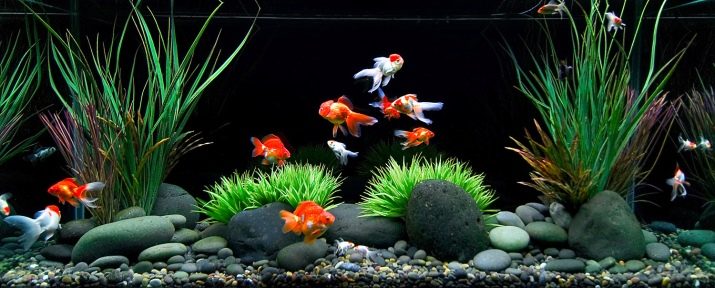
Important: long-bodied and short-bodied individuals cannot be planted in one aquarium. Due to the difference in temperament, they will harm each other.
You also need to check how much you can trust the sellers. You need to study the situation in advance and, starting from the answers to a well-known question, ask it in the store. If they answer evasively, refuse to speak, try to deceive, you can’t buy a goldfish.
Important: Aquariums at the pet store must be kept clean and tidy. It is necessary to know the main signs of sick specimens, such as:
- wrong coloring;
- too little or too much activity;
- unusual spots;
- sunken stomach;
- ulcers and wounds;
- growths where they should not be;
- muddy faded eyes.
For goldfish care, see below.










